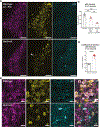Loss of mitochondrial enzyme GPT2 causes early neurodegeneration in locus coeruleus
- PMID: 35908744
- PMCID: PMC9669404
- DOI: 10.1016/j.nbd.2022.105831
Loss of mitochondrial enzyme GPT2 causes early neurodegeneration in locus coeruleus
Abstract
Locus coeruleus (LC) is among the first brain areas to degenerate in Alzheimer's disease and Parkinson's disease; however, the underlying causes for the vulnerability of LC neurons are not well defined. Here we report a novel mechanism of degeneration of LC neurons caused by loss of the mitochondrial enzyme glutamate pyruvate transaminase 2 (GPT2). GPT2 Deficiency is a newly-recognized childhood neurometabolic disorder. The GPT2 enzyme regulates cell growth through replenishment of tricarboxylic acid (TCA) cycle intermediates and modulation of amino acid metabolism. In Gpt2-null mice, we observe an early loss of tyrosine hydroxylase (TH)-positive neurons in LC and reduced soma size at postnatal day 18. Gpt2-null LC shows selective positive Fluoro-Jade C staining. Neuron loss is accompanied by selective, prominent microgliosis and astrogliosis in LC. We observe reduced noradrenergic projections to and norepinephrine levels in hippocampus and spinal cord. Whole cell recordings in Gpt2-null LC slices show reduced soma size and abnormal action potentials with altered firing kinetics. Strikingly, we observe early decreases in phosphorylated S6 in Gpt2-null LC, preceding prominent p62 aggregation, increased LC3B-II to LC3B-I ratio, and neuronal loss. These data are consistent with a possible mechanism involving deficiency in protein synthesis and cell growth, associated subsequently with abnormal autophagy and neurodegeneration. As compared to the few genetic animal models with LC degeneration, loss of LC neurons in Gpt2-null mice is developmentally the earliest. Early neuron loss in LC in a model of human neurometabolic disease provides important clues regarding the metabolic vulnerability of LC and may lead to new therapeutic targets.
Keywords: Autophagy; GPT2; Locus coeruleus; Neurodegeneration; Neurogenetics; Neurometabolism; Proteostasis; Selective vulnerability.
Copyright © 2022 The Authors. Published by Elsevier Inc. All rights reserved.
Conflict of interest statement
Declaration of Competing Interest The authors declare no competing interests.
Figures









Similar articles
-
Mitochondrial enzyme GPT2 regulates metabolic mechanisms required for neuron growth and motor function in vivo.Hum Mol Genet. 2022 Feb 21;31(4):587-603. doi: 10.1093/hmg/ddab269. Hum Mol Genet. 2022. PMID: 34519342 Free PMC article.
-
Loss of mitochondrial enzyme GPT2 leads to reprogramming of synaptic glutamate metabolism.Mol Brain. 2024 Nov 27;17(1):87. doi: 10.1186/s13041-024-01154-x. Mol Brain. 2024. PMID: 39604975 Free PMC article.
-
Critical role of somatostatin receptor 2 in the vulnerability of the central noradrenergic system: new aspects on Alzheimer's disease.Acta Neuropathol. 2015 Apr;129(4):541-63. doi: 10.1007/s00401-015-1394-3. Epub 2015 Feb 13. Acta Neuropathol. 2015. PMID: 25676386
-
Causes, consequences, and cures for neuroinflammation mediated via the locus coeruleus: noradrenergic signaling system.J Neurochem. 2016 Oct;139 Suppl 2:154-178. doi: 10.1111/jnc.13447. Epub 2016 Mar 10. J Neurochem. 2016. PMID: 26968403 Review.
-
The mechanistic link between selective vulnerability of the locus coeruleus and neurodegeneration in Alzheimer's disease.Acta Neuropathol. 2021 May;141(5):631-650. doi: 10.1007/s00401-020-02248-1. Epub 2021 Jan 11. Acta Neuropathol. 2021. PMID: 33427939 Free PMC article. Review.
Cited by
-
Noradrenergic signaling controls Alzheimer's disease pathology via activation of microglial β2 adrenergic receptors.bioRxiv [Preprint]. 2023 Dec 4:2023.12.01.569564. doi: 10.1101/2023.12.01.569564. bioRxiv. 2023. Update in: Brain Behav Immun. 2025 Aug;128:307-322. doi: 10.1016/j.bbi.2025.04.022. PMID: 38106167 Free PMC article. Updated. Preprint.
-
Regenerating Locus Coeruleus-Norepinephrine (LC-NE) Function: A Novel Approach for Neurodegenerative Diseases.Cell Prolif. 2025 Jun;58(6):e13807. doi: 10.1111/cpr.13807. Epub 2025 Jan 28. Cell Prolif. 2025. PMID: 39876531 Free PMC article. Review.
-
Noradrenergic signaling controls Alzheimer's disease pathology via activation of microglial β2 adrenergic receptors.Res Sq [Preprint]. 2024 Feb 26:rs.3.rs-3976896. doi: 10.21203/rs.3.rs-3976896/v1. Res Sq. 2024. Update in: Brain Behav Immun. 2025 Aug;128:307-322. doi: 10.1016/j.bbi.2025.04.022. PMID: 38464247 Free PMC article. Updated. Preprint.
-
A Mouse Model of Sporadic Alzheimer's Disease with Elements of Major Depression.Mol Neurobiol. 2025 Feb;62(2):1337-1358. doi: 10.1007/s12035-024-04346-7. Epub 2024 Jul 9. Mol Neurobiol. 2025. PMID: 38980563
-
Fading Blue: Exploring the Causes of Locus Coeruleus Damage Across the Lifespan.Antioxidants (Basel). 2025 Feb 22;14(3):255. doi: 10.3390/antiox14030255. Antioxidants (Basel). 2025. PMID: 40227216 Free PMC article. Review.
References
-
- Amaral D, Sinnamon H, 1977. The locus coeruleus: neurobiology of a central noradrenergic nucleus. Prog. Neurobiol 9, 147–196. - PubMed
-
- Aston-Jones G, Rajkowski J, Cohen J, 1999. Role of locus coeruleus in attention and behavioral flexibility. Biol. Psychiatry 46, 1309–1320. - PubMed
-
- Bartlett BJ, Isakson P, Lewerenz J, Sanchez H, Kotzebue RW, Cumming RC, Harris GL, Nezis IP, Schubert DR, Simonsen A, et al. , 2011. p62, ref(2)P and ubiquitinated proteins are conserved markers of neuronal aging, aggregate formation and progressive autophagic defects. Autophagy 7, 572–583. - PMC - PubMed
Publication types
MeSH terms
Substances
Grants and funding
LinkOut - more resources
Full Text Sources
Molecular Biology Databases
Research Materials

